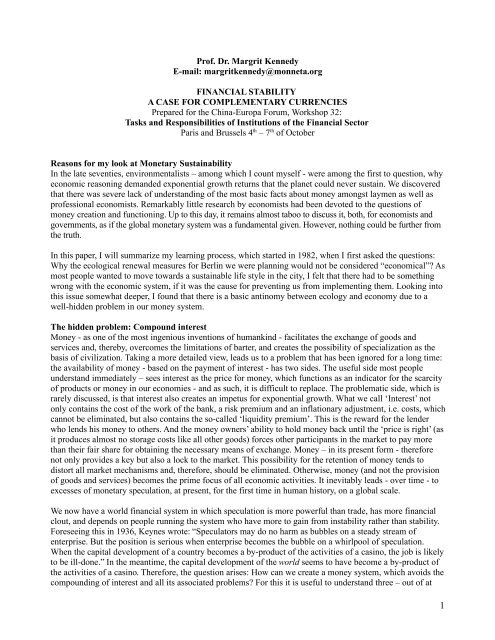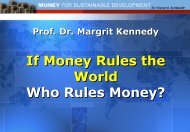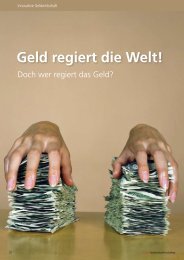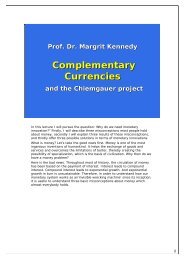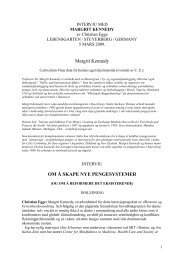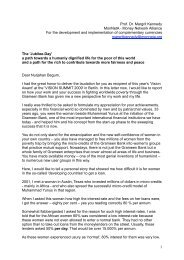Why we need Monetary Innovation - Prof. Dr. Margrit Kennedy
Why we need Monetary Innovation - Prof. Dr. Margrit Kennedy
Why we need Monetary Innovation - Prof. Dr. Margrit Kennedy
You also want an ePaper? Increase the reach of your titles
YUMPU automatically turns print PDFs into web optimized ePapers that Google loves.
<strong>Prof</strong>. <strong>Dr</strong>. <strong>Margrit</strong> <strong>Kennedy</strong><br />
E-mail: margritkennedy@monneta.org<br />
FINANCIAL STABILITY<br />
A CASE FOR COMPLEMENTARY CURRENCIES<br />
Prepared for the China-Europa Forum, Workshop 32:<br />
Tasks and Responsibilities of Institutions of the Financial Sector<br />
Paris and Brussels 4 th – 7 th of October<br />
Reasons for my look at <strong>Monetary</strong> Sustainability<br />
In the late seventies, environmentalists – among which I count myself - <strong>we</strong>re among the first to question, why<br />
economic reasoning demanded exponential growth returns that the planet could never sustain. We discovered<br />
that there was severe lack of understanding of the most basic facts about money amongst laymen as <strong>we</strong>ll as<br />
professional economists. Remarkably little research by economists had been devoted to the questions of<br />
money creation and functioning. Up to this day, it remains almost taboo to discuss it, both, for economists and<br />
governments, as if the global monetary system was a fundamental given. Ho<strong>we</strong>ver, nothing could be further from<br />
the truth.<br />
In this paper, I will summarize my learning process, which started in 1982, when I first asked the questions:<br />
<strong>Why</strong> the ecological renewal measures for Berlin <strong>we</strong> <strong>we</strong>re planning would not be considered “economical”? As<br />
most people wanted to move towards a sustainable life style in the city, I felt that there had to be something<br />
wrong with the economic system, if it was the cause for preventing us from implementing them. Looking into<br />
this issue somewhat deeper, I found that there is a basic antinomy bet<strong>we</strong>en ecology and economy due to a<br />
<strong>we</strong>ll-hidden problem in our money system.<br />
The hidden problem: Compound interest<br />
Money - as one of the most ingenious inventions of humankind - facilitates the exchange of goods and<br />
services and, thereby, overcomes the limitations of barter, and creates the possibility of specialization as the<br />
basis of civilization. Taking a more detailed view, leads us to a problem that has been ignored for a long time:<br />
the availability of money - based on the payment of interest - has two sides. The useful side most people<br />
understand immediately – sees interest as the price for money, which functions as an indicator for the scarcity<br />
of products or money in our economies - and as such, it is difficult to replace. The problematic side, which is<br />
rarely discussed, is that interest also creates an impetus for exponential growth. What <strong>we</strong> call ‘Interest’ not<br />
only contains the cost of the work of the bank, a risk premium and an inflationary adjustment, i.e. costs, which<br />
cannot be eliminated, but also contains the so-called ‘liquidity premium’. This is the reward for the lender<br />
who lends his money to others. And the money owners’ ability to hold money back until the ‘price is right’ (as<br />
it produces almost no storage costs like all other goods) forces other participants in the market to pay more<br />
than their fair share for obtaining the necessary means of exchange. Money – in its present form - therefore<br />
not only provides a key but also a lock to the market. This possibility for the retention of money tends to<br />
distort all market mechanisms and, therefore, should be eliminated. Otherwise, money (and not the provision<br />
of goods and services) becomes the prime focus of all economic activities. It inevitably leads - over time - to<br />
excesses of monetary speculation, at present, for the first time in human history, on a global scale.<br />
We now have a world financial system in which speculation is more po<strong>we</strong>rful than trade, has more financial<br />
clout, and depends on people running the system who have more to gain from instability rather than stability.<br />
Foreseeing this in 1936, Keynes wrote: “Speculators may do no harm as bubbles on a steady stream of<br />
enterprise. But the position is serious when enterprise becomes the bubble on a whirlpool of speculation.<br />
When the capital development of a country becomes a by-product of the activities of a casino, the job is likely<br />
to be ill-done.” In the meantime, the capital development of the world seems to have become a by-product of<br />
the activities of a casino. Therefore, the question arises: How can <strong>we</strong> create a money system, which avoids the<br />
compounding of interest and all its associated problems? For this it is useful to understand three – out of at<br />
1
least thirty - misconceptions about money, which almost everybody holds (Creutz, 2004).<br />
Three Misconceptions<br />
Growth<br />
1.The ‘Growth Misconception’ is based on the belief that money based on<br />
interest can grow forever - and this in turn is based on people not<br />
b<br />
understanding two generically different types of growth (Figure 1).<br />
Curve a represents the normal physical growth pattern in nature in which<br />
everything stops growing at an optimal size. This is the only sustainable<br />
growth pattern that exists.<br />
a<br />
Curve b represents exponential growth doubling its units at regular intervals.<br />
It may be described as the exact opposite to curve a, in that it grows slowly in<br />
Time the beginning, then accelerates continually faster and, finally, grows in an<br />
almost vertical fashion. Based on interest and compound interest, our money<br />
follows an exponential growth pattern: at 3% compound interest it doubles in 24 years; at 6% it takes 12<br />
years; at 12% 6 years. To show the impact on money in the long run, <strong>we</strong> may use the famous example of<br />
Josephs’ cent invested at 5% interest in the year 0. In the year 2000 this cent would be worth over 500 billion<br />
balls of gold of the <strong>we</strong>ight of the earth, at the price of gold in that year. Without the compounding of interest,<br />
the sum accumulated would have been 1,01 €. This shows that it is not interest that is the problem, but the<br />
compounding of interest. Through the use of the ‘discounted cash flow’, ho<strong>we</strong>ver, interest and compound<br />
interest provide the basis for all evaluations of economic efficiency for investments in conventional<br />
currencies.<br />
2. The ‘Transparency Misconception’ deals with the second major difficulty in fully understanding the impact<br />
of the interest mechanism on our economic system. Most people think that they pay interest only if they<br />
borrow money. They do not understand the fact that every price contains a certain amount of interest,<br />
depending on the share of capital deployed per unit of output. This relationship – together with the rate of<br />
interest – determines the interest component in prices. For the three following examples from Germany, it<br />
ranges from a 12 % interest component in the price for garbage collection (because here the share of capital<br />
costs is relatively low and the share of physical labor is particularly high) to 38% for drinking water - and up<br />
to 77% in the rent for public housing (when calculated over 100 years, which is the estimated time houses in<br />
Germany are supposed to last). On average, people in Germany pay about 45% interest in the prices of goods<br />
and services they <strong>need</strong> for their life.<br />
3. The ‘Fairness Misconception’ is based on the notion that everyone<br />
is treated equally in our monetary system. We all have to pay interest<br />
when borrowing money and receive interest for savings. Ho<strong>we</strong>ver,<br />
when <strong>we</strong> take a closer look, there are indeed huge differences as to<br />
who profits and who pays in this system. Comparing the average<br />
interest payments and income from interest in ten equal parts of 2.5<br />
million households in Germany, <strong>we</strong> can show that 80% of the<br />
population pay almost twice as much as they receive, 10% receive<br />
slightly more than they pay, and the remaining 10% receive more than<br />
twice as much interest as they pay. This last amount is the share that<br />
the first 80% loses (Fig.2).<br />
This illustrates one of the least understood reasons why the rich get<br />
richer and the poor get poorer - and that the economists’ notion that<br />
money is just a neutral measure for the economy is incorrect. In<br />
Germany, in the year 2004, about 1 billion euros <strong>we</strong>re transferred<br />
every day from those who work for their money to those who can<br />
make their ‘money work for them’ (Creutz, 2004). But money never<br />
‘works’. Only people and machines produce real value. Money can only be re-distributed from those who<br />
create that value to those who own money. In other words, <strong>we</strong> allow the operation of a hidden redistribution<br />
mechanism in our monetary system, which continually transfers money from the large majority to a small<br />
2
minority, creating a social polarization that undermines any democracy over time. An Argentinian banker, who<br />
had worked in the National Central Bank for 36 years, once remarked – in regard to this figure: “…and what<br />
use is equality before the law for us, without equality before the money?”<br />
Even more to the point, President Obasonjo of Nigeria stated after the G8 summit in Okinawa in 2000: “All<br />
that <strong>we</strong> borro<strong>we</strong>d up to 1985 or 1986 was about $5 billion. So far <strong>we</strong> have paid back about $16 billion. Yet<br />
<strong>we</strong>’re being told that <strong>we</strong> still o<strong>we</strong> about $28 billion … because of foreign creditors’ interest rates. If you ask<br />
me what is the worst thing in the world, I will say it is compound interest.”<br />
At that time, the developing world was spending thirteen dollars on debt repayment for every one dollar it<br />
received in foreign aid and grants (Lietaer, 2007).<br />
Three Results<br />
1. Inflation: As one result of this defect in our monetary system every Deutsche Mark lost 80% of its value<br />
bet<strong>we</strong>en 1950 and 2001 - and this was the most stable currency in the world. For most people, inflation seems<br />
like an integral part of any money system - almost ‘natural’ - since there is no country in the world without<br />
inflation. Because inflation is perceived as a given, economists and most people believe interest is <strong>need</strong>ed to<br />
counteract inflation, while in fact interest is the major cause of inflation. True, the short-term relationship<br />
bet<strong>we</strong>en the rate of interest and the rate of inflation is different. It corresponds with conventional wisdom: A<br />
reduction of interest rates makes credit easier and encourages capital and consumer spending. The result is an<br />
expansion of the money supply and – in most cases – eventually a rise of the rate of inflation. Vice versa, an<br />
increase of interest rates slows down the economy, reduces the money supply and counters inflation.<br />
Empirical evidence substantiates this. But what happens in the long run? What is the relationship bet<strong>we</strong>en<br />
interest rates and inflation over a period of – say 50 to 100 years?<br />
Empirical research doesn’t give us much of a clue as it is very difficult – if not impossible – to empirically<br />
identify a clear cause and its effect and exclude the impact of other effects over such a long time span. Still,<br />
what <strong>we</strong> do know is the following: The creation of money is carried out via bank loans. Whoever receives<br />
these loans has to repay them with interest and compound interest. If <strong>we</strong> consider the world economy, it<br />
follows that the amount of money in circulation is systematically insufficient to repay all debt. Leaving aside<br />
temporary contractions, it is only by a continuous expansion of the money supply that economic actors as a<br />
whole can sustain their ability to pay. And more: In order to meet the accumulating liabilities resulting from<br />
compound interest, it even has to be an exponential expansion. Common sense tells us – and empirical data<br />
confirms – that an exponential expansion of the producing-economy is impossible over the long run. Hence,<br />
an exponential raise of M1 – that aggregate of money that is available for payments immediately – has to be<br />
avoided if hyperinflation is to be prevented.<br />
So where is exponential growth actually taking place? The asset markets holds the ans<strong>we</strong>r. It is in the number<br />
of assets and in the asset evaluations – and this is especially true for the securities market that has grown<br />
exponentially over the past decades. Ho<strong>we</strong>ver, unless this rise corresponds with a comparable rise in the<br />
producing-economy their surge is excessive. These overvalued assets<br />
serve as backing for creating loans. But - if the backing is getting<br />
<strong>we</strong>aker - how is the money supposed not to lose solidity? In a<br />
monetary system with compound interest, inflation cannot be<br />
prevented. At best, it can be kept at low levels for a number of<br />
decades. Ultimately, a correction – that means a massive and painful<br />
adjustment – is inevitable. We probably see the beginnings of this<br />
process right now.<br />
2. <strong>Monetary</strong> instability is a second result of the exponential growth<br />
pattern in our money system. In contrast to measures like the meter or<br />
the kilogram, <strong>we</strong> are used to the fact that the exchange rate of our<br />
currencies varies almost daily. Cashing in on this variability, the<br />
global volume of speculative foreign currency transactions bet<strong>we</strong>en<br />
1974 and 2004 increased to 97%, with a mere 3% of the transactions<br />
3
serving the exchange of goods and services, including tourism. Recent figures in 2007 show that the daily<br />
volume of trading already exceeds $3,200 billion - whereas in the 1970ies it amounted to just $20-30 billion.<br />
What makes the situation so dangerous is that it creates economic instability on a global scale. In the early<br />
1990s, for instance, speculative money flo<strong>we</strong>d massively into Thailand, Malaysia and Korea, only to be<br />
withdrawn a few <strong>we</strong>eks later. Where these speculators withdrew, they left devastating effects on the culture,<br />
ecology and society.<br />
3. An uneven growth of different sectors in the economy is one further result. Comparing three different<br />
indicators of net growth bet<strong>we</strong>en 1950 and 1995 in Germany, <strong>we</strong> find that monetary assets - backed by an<br />
equivalent amount of debt - increased 461 times; the Gross National Product increased 141 times; and the net<br />
income in real wages and salaries (after tax) rose only 18 times (it actually declined after 1980 to the level of<br />
the 1970ies). Few people understand that these figures drifting further and further apart indicate a severe<br />
sickness of our economic system and a growing polarization of our societies. Many believe that those 10%<br />
who profit from the system are the culprits who will not allow any change. Ho<strong>we</strong>ver, even the rich are just as<br />
helpless to change it as the poor who pay more than their fair share. The late billionaire Sir James Goldsmith<br />
once said: “What use is more money to me when I will be surrounded by more and more poor and suffering<br />
people who hate me? I feel as if I have won a game of poker on the Titanic!”<br />
A recent study of the Club of Rome proves that money is anything but neutral (Brunnhuber, Klimenta, 2003).<br />
It changes the kind of trades being performed as <strong>we</strong>ll as the relationships among the people using it. What <strong>we</strong><br />
<strong>need</strong> today is another perspective on money in order, finally, to be able to use the full potential of one of the<br />
most ingenious inventions of mankind, and to provide everyone on this earth with the basic necessities of life.<br />
Three Historical Solutions<br />
The religious leaders of Judaism, Islam and Christianity understood the problems of compounding interest and<br />
left us solutions how to deal with it:<br />
• In Islam people who follow the Sharia observe a complex set of rules to prevent interest from<br />
compounding. It forbids not only investments in morally or socially prohibitive activities but also<br />
speculation and excessive costs of loans and, consequently, makes the moneylenders - whether private or<br />
professional - a part of the project, which they are financing. Therefore, they have a strong sense of<br />
responsibility for its continuity and success.<br />
• Judaism used to resolve the problem of compounding interest by waiving all debt regularly every seven<br />
years in the so-called “jubilee year”. After 7 x 7 or 49 years not only debts <strong>we</strong>re ‘for-given’ and debtslaves<br />
<strong>we</strong>re freed, but also private land was given back to the community.<br />
• The Christian churches in Europe, mainly during the Middle Ages bet<strong>we</strong>en 900 and 1400 a.D., imposed<br />
strict interest prohibition laws. They punished those who levied interest on loans severely excluding them<br />
from the Christian community and Christian funerals. Money was kept in circulation by regularly recalling<br />
and re-minting the thin metal coins - in some areas called Brakteaten - every 3 to 4 years and by<br />
levying a fee of 30 – 40 % in the renewal process. This was - at the same time - a way of collecting taxes.<br />
The use of the old coins was forbidden by law and sanctioned by prison sentences. This time related<br />
charge on money – called ‘demurrage’ – acted as a ‘circulation incentive’ and meant that nobody was able<br />
to hoard money without risking a loss. Instead of charging interest, people usually accepted loans that<br />
guaranteed the equivalent value after some months or years - and thus they eliminated the ‘liquidity<br />
premium’ or reward for the lender, which causes the compounding of interest. In terms of modern banking<br />
practices, leaving out this share in the cost of interest would halve the costs for loans and subsequently –<br />
over time - the 45% share of interest in prices.<br />
All three historic solutions have remained alive up to this day: The Islamic model is finding more and more<br />
acceptance among the Muslim population in view of the failure of the capitalist money system to provide for<br />
systemic stability and fairness. The Jewish model of waiving the debts has been advocated to counteract the<br />
capitalist money systems’ inability to deal with social justice - in terms of the waiving the outstanding loans of<br />
the lest developed countries. And many of the complementary currencies now running in Germany are using<br />
demurrage as a circulation incentive.<br />
4
Where these solutions have not been applied, three historic consequences have arisen: hyperinflation (or<br />
crash), social revolution and war. Ho<strong>we</strong>ver, neither the 87 monetary crashes over the last 25 years (Lietaer<br />
2007), nor both World Wars, nor social revolutions like the French, Russian or Chinese, have changed<br />
anything fundamental in terms of the money system.<br />
Various complementary currency models that tried to resolve the problem of compound interest through a<br />
time-related fee in order to keep money in circulation. They proved their potential to create employment and<br />
solve social problems in the 1930s in Austria and Germany - just before Hitler gained po<strong>we</strong>r. Ho<strong>we</strong>ver, they<br />
<strong>we</strong>re discontinued on ‘legal’ grounds - as they threatened the monopoly of central banks. It is, therefore, of<br />
paramount importance to start communicating with central banks, now, in order to create a sustainable legal<br />
framework for complementary currency systems on a scale that counts. Otherwise, <strong>we</strong> are heading for the<br />
abyss yet another time. This time the options seem to be crash or war.<br />
One additional approach for ‘taming’ the economy comes from a Buddhist perspective. In contrast to Adam<br />
Smith’s “invisible hand” - and the liberal and neo-liberal acceptance of the profit motive in all individuals,<br />
Brodbeck (2007) points out that the starting point of a Buddhist economy is every individual’s freedom to<br />
recognize what is true for enhancing life and to change its behavior accordingly. Thus, <strong>we</strong> can overcome the<br />
three ‘poisons’ that are part of the accepted theoretical and practical basis of the global market economy:<br />
ignorance, greed and aggression.<br />
Complementary Currencies and the Use of Demurrage<br />
Complementary Currencies (CCs) may be defined as means of payment with a built-in target. They are not<br />
meant to replace the existing national or international currencies but to complement them. Mainly in social,<br />
cultural and ecological areas in which the present system does not work very <strong>we</strong>ll, new liquidity can be<br />
created without burdening the taxpayer or governments with additional costs. CCs can be seen as a po<strong>we</strong>rful<br />
tool for strengthening the economic viability of a specific social sector or geographically limited region<br />
(defined here as an area bet<strong>we</strong>en the local and the national). In many instances, they have proven their<br />
potential to support and strengthen the economy - especially in economically difficult periods. The Fureai<br />
Kippu Care Ticket in Japan, for instance, helps to provide care for millions of elderly people, based on hours<br />
of service. The WIR Wirtschaftsring in Switzerland is a parallel currency to the Swiss Franc and strengthens<br />
the economic viability of 20% of the small and medium sized businesses, which in turn create over 80% of all<br />
jobs. And the Saber (a proposed educational voucher system for Brazil) is designed to strengthen the<br />
educational system.<br />
The Brazilian ‘Saber’ demonstrates clearly the different design features of complementary currencies in<br />
comparison to conventional currencies. That is the reason why I want to describe it here in more detail. In<br />
Brazil 40% of the population is less than 15 years of age. This causes an enormous educational problem.<br />
When the mobile phone industry was privatized, the government levied a 1% surcharge for education on all<br />
mobile phone bills. This resulted in a fund of 1 billion US$ or 3 billion Reais for education in 2004. Bernard<br />
Lietaer proposed the introduction of a voucher system called “Saber” in order to increase the number of<br />
students that could afford a college level education. The vouchers would be given to schools for the youngest<br />
(e.g. the 7 year-old) pupils, on the condition that they would chose a mentor from an older class to strengthen<br />
their <strong>we</strong>aker subjects. The Saber would then move to the older schoolchildren, and so on until, at last, seniors<br />
of 17 years (who want to go to university) would use the Sabers to pay a part of their tuition. While the value<br />
of the Saber would be the same as the Real, nominally, it would only be redeemable for tuition payments for<br />
higher education. In addition, it would lose 20% per year as an incentive to pass it on - unless it had reached<br />
the universities. Thus (including a reduced tuition rate for those subjects with free spaces in the universities),<br />
the Saber system would multiply by ten times what a direct allocation of the resources for education would<br />
otherwise allow and, thereby, create ten times the amount of education services.<br />
Differences bet<strong>we</strong>en complementary and traditional currencies<br />
The differences bet<strong>we</strong>en complementary and traditional currencies are marked indeed:<br />
5
• Instead of being profit-oriented they are use-oriented - their primary goal is to connect underutilized<br />
resources with unmet demands.<br />
• They are clearly marked as not being legal tender - thus their acceptance is entirely voluntary.<br />
• Their limited - instead of general - acceptance provides a “semi-permeable membrane” around the<br />
function (or the region) for which they are designed; they cannot be used to buy products from abroad or<br />
to speculate on the international financial markets.<br />
• Most of the complementary currencies do not charge interest but use a circulation incentive or a<br />
demurrage mechanism to keep the currency “on the move”; thus they avoid all the dire consequences<br />
associated with interest.<br />
• They can be established through a transparent process and, therefore, can be democratically controlled by<br />
the users.<br />
• As they are always 100% covered by services or products, they are not inflating<br />
• They are a proven means to counteract economic boom and bust cycles in contrast to conventional<br />
currencies, and thus support the policies of central banks and governments (Stodder, 1998)<br />
• They can stop the drain of financial resources to low-wage countries, thereby calling a halt to the resulting<br />
loss of <strong>we</strong>alth and job opportunities, and promoting community instead of destroying it.<br />
• They create a win-win situation for everybody: from an expansion of educational benefits to solving the<br />
problems of the increasing numbers of elderly, from the protection of cultural identity to marketing<br />
regionally grown foods, from an ecologically sensible use of the shortest transportation routes to<br />
exercising ethical concerns when utilizing non-renewable resources, providing closer links bet<strong>we</strong>en<br />
consumers and producers and helping to re-animate local and regional identity and diversity.<br />
One additional difference and reason for the introduction of complementary currencies on a scale that counts,<br />
would be the massive redemption of tax revenue that is, at present, evaded due to multinational companies<br />
playing off national tax authorities against each other in such a way that many of them pay very little or no tax<br />
in their home economies. Somewhere bet<strong>we</strong>en a sixth and a third of all the money in the world - is now<br />
lodged offshore, and though it re-enters the economy, it does so mostly in the form of short-term speculation<br />
in the growth centres of the world (Doyle and Kanoor, 2006).<br />
Regional Complementary Currencies<br />
In addition to the above list of advantages, regional currencies offer a feasible way to counteract the negative<br />
consequences of financial globalization. They allow a partial decoupling from the global financial system, and<br />
thus, may become an effective life raft in the case of a global financial meltdown. Everyone who accepts<br />
“Regios” - as they are often called - will pass them on to another person who shops with it in the region.<br />
Of altogether 22 practical examples of regional<br />
currencies that are, presently, up and running in<br />
Germany - one of the first is the Chiemgauer,<br />
circulating in the region around Lake Chiem, Bavaria.<br />
Initiated in January 2003, it uses a voucher model. A<br />
bonus of 3 % is given to selected regional associations<br />
for purchasing Chiemgauer vouchers. The associations<br />
in turn sell 1Chiemgauer for 1Euro to their members,<br />
who profit by supporting their association without<br />
paying for it. The members can spend it in over 560<br />
participating shops. The 2000 participants accept an<br />
annual fee of 8% to guarantee circulation. Four times, a<br />
year a stamp (worth 2% of the value of the voucher)<br />
has to be attached to Chiemgauer notes in order for<br />
them to retain their nominal value. The businesses that<br />
accept the vouchers can either exchange them for Euros at a five percent fee - or can use them for paying other<br />
businesses. If they pass the vouchers on, they do not have to pay the fee. Both exchange fee and circulation<br />
incentive are tax deductible, because they are seen as customer loyalty schemes. Since August 2006, an<br />
electronic version of the Chiemgauer is being used in Wasserburg/Inn, which makes it easier to deduct this<br />
6
time-related fee. The 550.000,- Chiemgauer that <strong>we</strong>re issued in 2006 circulated about 3 times as fast as the<br />
Euro. They changed hands over 20times, while the Euro changed hands on average 7times per year, thus<br />
creating and keeping the added in the region (www.Chiemgauer.Info).<br />
A new model amongst the complementary regional currencies in Germany is the ‘SonnenSchein’ (translates as<br />
sun-note and sun-shine) a currency backed 100% by kilowatt-hours from renewable energy production. It<br />
combines two recent innovations and synergizes their effects: firstly, the German feed-in legislation that<br />
allows those who invest in the provision of solar energy a secure return on their investment – at the expense of<br />
all the customers of electricity - (a model, which is now copied by over 40 countries around the world) and<br />
secondly, the experiences of 22 initiatives in Germany, which have already issued their own regional<br />
complementary currency. The ‘SonnenSchein’ is designed to enhance the use of renewable energy and create<br />
the backing for a complementary regional currency through the “kWh-harvest” which is going to increase in<br />
value as fossil fuels get more expensive. Thus, the inhabitants of the region can acquire a stable, inflationproof<br />
and crash-resistant currency. Unless necessary - as in the case of a crash or hyperinflation of the euro - it<br />
will not be subject to a fee or demurrage, as the initiators believe that the limited acceptance in the region<br />
provides enough of an incentive to use it before spending the euro. (www.sonnen-scheine.de)<br />
Conclusions<br />
While complementary sectoral and regional currencies can show how applying relatively small amounts of<br />
energy and resources at the right time and place can produce maximum advantageous change, it should be<br />
made clear that their basic tenets can also be applied on a larger scale. At least two solutions for<br />
complementary currencies that are meant to operate on a worldwide scale should be mentioned: the emissionsbacked<br />
currency unit called “EBCU” (Douthwaite, 1998); and the “Terra”, a global Trade Reference Currency<br />
(Lietaer, 2007). Both aim at adding more fairness, sustainability and stability to our international monetary<br />
systems.<br />
The solutions for monetary sustainability and financial stability, presented here, will be a surprise for<br />
conventional economic thinking, which invariably assumes monopolies for national moneys as an<br />
unquestionable given. What the above examples are trying to show is that monetary sustainability will be<br />
enhanced by a diversity of currency systems, so that multiple and more diverse channels of monetary links<br />
and exchanges can emerge. We have all the technologies to make the use of multiple currencies feasible.<br />
Ho<strong>we</strong>ver, complementary currencies operate as yet at the margins of the official system. While they are<br />
proving their capacity to play a stabilizing role on a small scale, it is urgent to recognize that they can<br />
contribute to sustaining the global economic system tomorrow, if they are able to grow to a scale necessary for<br />
them to make a difference. For allowing this to happen, a co-operation bet<strong>we</strong>en central banks and federations<br />
of complementary currency associations - which formulate quality criteria and observe their implementation -<br />
is an essential pre-condition.<br />
Literature:<br />
Boyle, David and Kanoor, Sony (forthcoming): Money, World Future Council - Briefing, London.<br />
Brodbeck, Karl-Heinz (forthcoming): Beiträge zur Grundlegung einer buddhistischen Ökonomie, Gröbenzell.<br />
Brunnhuber, Stefan and Klimenta, Harald (2003): Wie wir wirtschaften <strong>we</strong>rden, Frankfurt.<br />
Creutz, Helmut (2005): Die 29 Irrtümer rund ums Geld, München.<br />
Douthwaite, Richard (1998): The Ecology of Money,Totnes.<br />
Fisher, Irving(1933): Stamp Scrip, Adelphi, New York.<br />
<strong>Kennedy</strong>, <strong>Margrit</strong> (1995): Interest and Inflation-free Money, Okemos.<br />
<strong>Kennedy</strong>, <strong>Margrit</strong> and Lietaer, Bernard (2004): Regionalwaehrungen, München.<br />
Keynes, John Maynard (1936): The General Theory of Employment, Interest and Money, London.<br />
Lietaer, Bernard (2001): The Future of Money, London.<br />
Lietaer, Bernard (2007): The Terra TRC-TM White Paper, www.terratrc.org<br />
Lietaer, Bernard and Belgin, Stephen (2006): Of Human Wealth - Beyond Greed and Scarcity, Boulder.<br />
Robertson, James and Huber, Joseph (2000): Creating New Money, New Economics Foundation.<br />
Stodder, James: ‘Corporate barter and economic stabilisation’, International Journal of Community Currency Research,<br />
Vol 2, 1998.<br />
7


